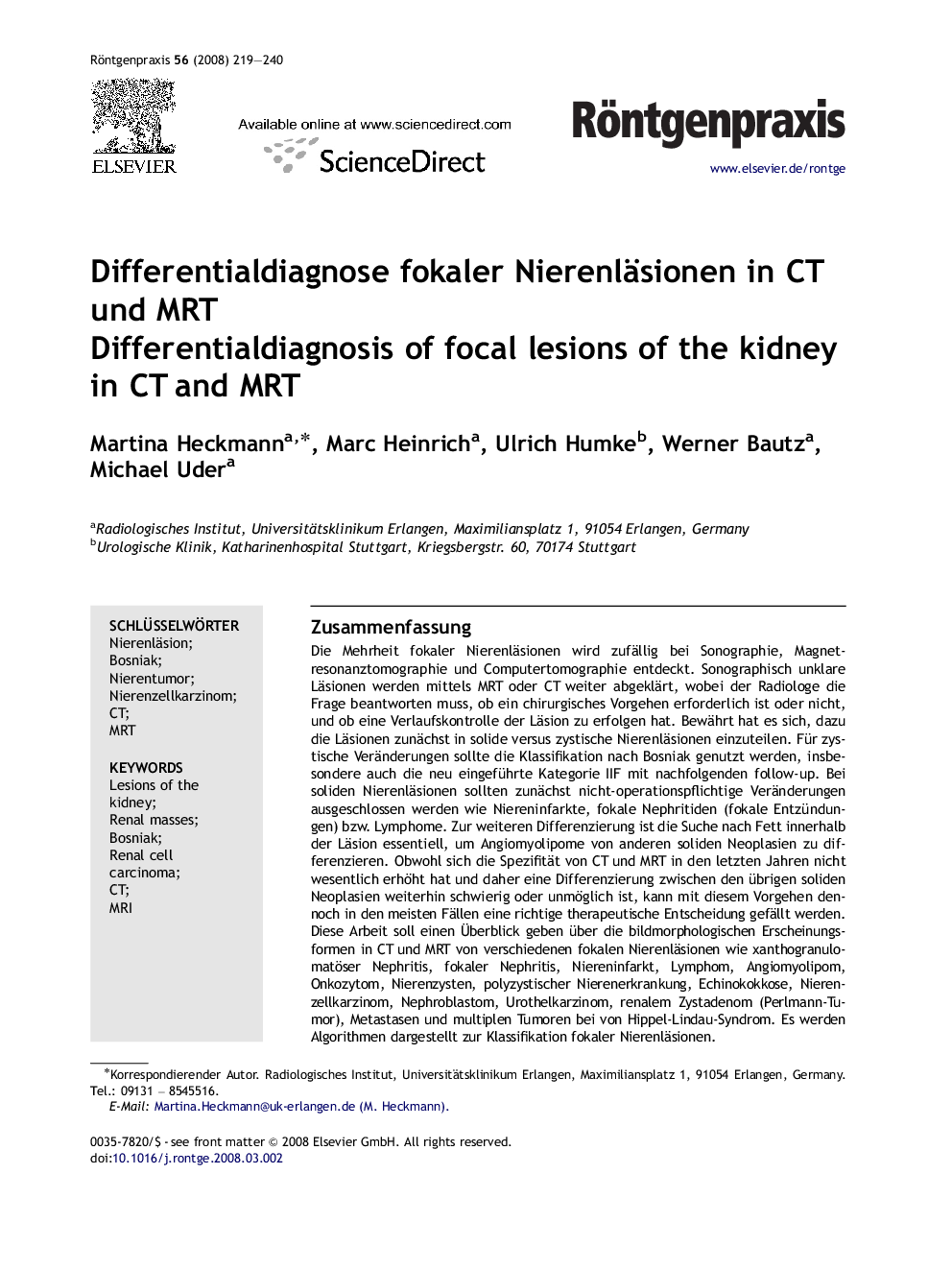| Article ID | Journal | Published Year | Pages | File Type |
|---|---|---|---|---|
| 4250764 | Röntgenpraxis | 2008 | 22 Pages |
ZusammenfassungDie Mehrheit fokaler Nierenläsionen wird zufällig bei Sonographie, Magnetresonanztomographie und Computertomographie entdeckt. Sonographisch unklare Läsionen werden mittels MRT oder CT weiter abgeklärt, wobei der Radiologe die Frage beantworten muss, ob ein chirurgisches Vorgehen erforderlich ist oder nicht, und ob eine Verlaufskontrolle der Läsion zu erfolgen hat. Bewährt hat es sich, dazu die Läsionen zunächst in solide versus zystische Nierenläsionen einzuteilen. Für zystische Veränderungen sollte die Klassifikation nach Bosniak genutzt werden, insbesondere auch die neu eingeführte Kategorie IIF mit nachfolgenden follow-up. Bei soliden Nierenläsionen sollten zunächst nicht-operationspflichtige Veränderungen ausgeschlossen werden wie Niereninfarkte, fokale Nephritiden (fokale Entzündungen) bzw. Lymphome. Zur weiteren Differenzierung ist die Suche nach Fett innerhalb der Läsion essentiell, um Angiomyolipome von anderen soliden Neoplasien zu differenzieren. Obwohl sich die Spezifität von CT und MRT in den letzten Jahren nicht wesentlich erhöht hat und daher eine Differenzierung zwischen den übrigen soliden Neoplasien weiterhin schwierig oder unmöglich ist, kann mit diesem Vorgehen dennoch in den meisten Fällen eine richtige therapeutische Entscheidung gefällt werden.Diese Arbeit soll einen Überblick geben über die bildmorphologischen Erscheinungsformen in CT und MRT von verschiedenen fokalen Nierenläsionen wie xanthogranulomatöser Nephritis, fokaler Nephritis, Niereninfarkt, Lymphom, Angiomyolipom, Onkozytom, Nierenzysten, polyzystischer Nierenerkrankung, Echinokokkose, Nierenzellkarzinom, Nephroblastom, Urothelkarzinom, renalem Zystadenom (Perlmann-Tumor), Metastasen und multiplen Tumoren bei von Hippel-Lindau-Syndrom. Es werden Algorithmen dargestellt zur Klassifikation fokaler Nierenläsionen.Lernziele: Durch Anwendung der Bosniak-Klassifikation, insbesondere auch unter Berücksichtigung der neuen Kategorie IIF, sollen zystische Nierenläsionen klassifiziert werden können. Fokale Nierenläsionen sollen differenziert werden können in operationspflichtige und nicht operationspflichtige Läsionen, sowie in Läsionen, die einer Verlaufskontrolle bedürfen.
The great majority of renal masses are found incidentally as a result of the use of ultrasonography, computed tomography (CT) and magnetic resonance imaging (MRI). If ultrasonography is not diagnostic CT or MRI should be initiated to differentiate lesions of the kidney that need surgical intervention from those that do not and from those that need follow-up examinations.Cystic renal masses are characterized by using the Bosniak classification, including category IIF. In solid lesions of the kidney first non-surgical lesions as well as lymphoma, renal infarction and nephritis should be excluded. Identifying fatty components in renal lesions is very important because in angiomyolipoma they are almost always present.CT and MRI are exellent for tumor detection. Careful evaluation of imaging finding combined with the patient′s history should assist the radiologist in making the proper diagnosis or recommending the appropriate treatment in most cases.This article provides a review about renal masses, the imaging methods for their evaluation and their characteristic features at CT and MR imaging. Different lesions are demonstrated like xantogranulomatous pyelonephritis, acute pyelonephritis, renal infarction, lymphoma, angiomyolipoma, renal oncocytoma, cystic lesion and polycystic disease the kidney, echinococcosis, renal cystadenoma, metastases, renal cell carcinoma (RCC), and multiple bilateral RCC in patients with Hippel-Lindau-Syndrome.This article should help to differentiate complex cystic lesions of the kidney by using the Bosniak-classification, especially Bosniak Category IIF. Solid masses should be characterized and the major question to be answered is whether the mass represents a surgical or nonsurgical lesion or if follow-up studies are necessary.
